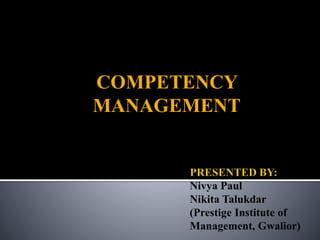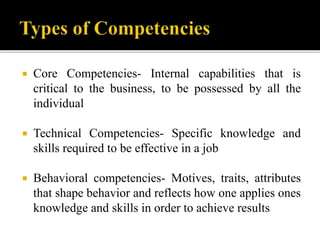Competency Management
- 2. ïĄ Competencies are personal capabilities that are demonstrated through measurable knowledge, skills, abilities, and personal attributes, which can contribute to enhance employee performance and ultimately, adds to the individual's and organization's success.
- 3. Skill is ïĄ Ability accomplish Talent is ïĄ Inherent ability Competency is ïĄ Underline characteristics that give rise to skill accomplishment ïĄ Knowledge, skill and attitude
- 4. ïĄ Competency management is the set of management practices that identify and optimize the skills and competencies required to deliver on an organizationâs business strategy. Competency management provides the foundation to manage strategic talent management practices such as workforce planning, acquiring top talent, and developing employees to optimize their strengths.
- 5. Research indicates that ïĄ Source of 50% of job performance problems is that people are in the wrong job. ïĄ 25% of on-the-job performance problems is the inability to identify the âgapsâ between the competencies of the person and the requirements of the job.
- 6. ïĄ Training ïĄ Job Rotation ïĄ Coaching ïĄ Mentoring
- 7. ïĄ Enriched understanding of expected behaviors and performance ïĄ Improved talent planning ïĄ Optimized development and mobility strategy ïĄ Enhanced talent pipeline ïĄ Improved operational efficiencies ïĄ Integrated talent processes
- 8. ïĄ Identification of critical competencies is difficult ïĄ Alignment of competency development with business goals is weak ïĄ Investment in competency management is de prioritized ïĄ Competency models are exclusive of technical competencies ïĄ Competencies are too often paper-based
- 9. ïĄ Adaptability ïĄ Commitment ïĄ Creativity ïĄ Motivation ïĄ Foresight ïĄ Leadership ïĄ Independence ïĄ Emotional Stability ïĄ Analytical Reasoning ïĄ Communication Skills
- 10. ïĄ Core Competencies- Internal capabilities that is critical to the business, to be possessed by all the individual ïĄ Technical Competencies- Specific knowledge and skills required to be effective in a job ïĄ Behavioral competencies- Motives, traits, attributes that shape behavior and reflects how one applies ones knowledge and skills in order to achieve results
- 11. ïĄ Threshold competencies- characteristics required by a jobholder to perform job effectively ïĄ Differentiating Competencies- Characteristics which differentiate superior performers from average performers
- 12. Following methods are used: ïĄ Assessment/Development Centre ïĄ 360 Degree feedback ïĄ Role plays ïĄ Case study ïĄ Structured Experiences ïĄ Structured Experiences/Simulations/Business Games ïĄ Benchmarking & Case study ïĄ Management Climate Study ïĄ Top Performer Survey













